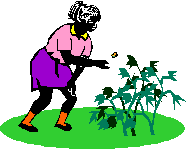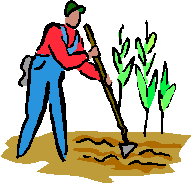|
Looking for lists and images to identify weeds in your
state or
province? Every state and province in North America has a
unique assortment of weeds that are either noxious or a nuisance
depending on how certain weeds affect the indigenous flora and
agriculture.
A given weed identified as noxious in one state may not pose a threat in
another state, even if it may be established in both areas. In the last
few years, to the convenience of home gardeners and professionals alike,
many weed ID
lists have found a new home on the Web!
Over 200 weed ID lists and databases are listed and described on these pages,
including information about images, costs (if any), list criteria, number of
species, and authors. They are sorted by multi-state regions
followed by individual states or provinces in alphabetical order.
Most states have passed legislation to identify noxious weeds and other
types of weeds that should be managed carefully. Legislation often
forbids the movement of noxious weed seed into the state. Some
weeds are classified with restricted movement in counties where the
county has administrative authority.
Several lists also identify poisonous plants and some lists include maps
of the distribution of weeds in various regions. There is a lot of
interesting information on many of these lists, including the history of
when and how weeds were introduced to the region, the way they are often
transported, costs to agriculture and land management, and impacts on
other flora and fauna.
To identify a weed in your area, we suggest you look at the lists
identified for your state or province. The lists in this website
derive from regional legislation or from agricultural scientists with
expertise in weed science. Most of the online lists include
images or illustrations to help you identify your weeds. If the
online images and descriptions are not sufficient to identify a specific
weed in your area, you may find many weed images by name by using
Google or
Yahoo! image search tools. The images from Google and
Yahoo! usually link to more information about the image content.
The Ergonica menu header above also provides convenient links to these
search tools. You may need to use these links when viewing lists
with no pictures.
Most lists are free, online references with common names
and images or illustrations. All entries are linked
directly to their source or location for purchase. Your taxes most
likely paid for at least part of the costs of researching the
information, photographing the plants, and publishing them on the Web or
in other formats. Some lists of weeds without photos have been
included in order to reveal the status or location of weeds in a given
region.
Several other books, pamphlets and DVD-ROMs are also included that are not free.
These are useful references often with higher quality images or
convenient user software to identify weeds by key features, such as
flower colors and leaf size and shape. The information on this
website will help you decide whether a free list will satisfy your needs,
or whether you need another reference that you can carry to the fields in a
bag or laptop computer.
Interactive Weed Identification Key Selection
To appreciate the convenience of
interactive identification key software, similar to those
provided by some CD-ROMs and DVDs, look at the
Weed Identification web site
published by the Illinois Council on Food and Agricultural Research.
Using a web form, you can select information about an unidentified weed,
and compare it with photographs and text descriptions of weeds that
share similar characteristics. Keys with prompts include features of leaves,
flowers, growth, ligules and life cycle. With just a few clicks of
a mouse, the database of weeds displayed on the form reduces in number
from 280 to as few as one or two.
Now including Apple iPhone, iPad and Google Android apps, a Weed ID Guide
updated in 2013 by the University of Missouri Division of Plant Sciences
enables quick selection of weeds from a list of 424 broadleaf and grassy
or grass-like species by selecting features displayed in drop-down
lists. With each selection the displayed list of weeds is reduced
accordingly and when the selection is small enough, thumbnail images
accompany the names. Great images and ease-of-use make this
a quick way to learn about most of the common weeds in North America.
And the web access, iTunes downloads and Google Play Store apps are
all free!
The University of Wisconsin-Madison in 2008 published a practical
online tool to select species from a database of 280 of the most common
weeds/invasive plants found in agricultural, urban, and natural settings
in Wisconsin. First you select whether the plant is grasslike,
broadleaf or woody. Then you identify one or more other features
such as the type of terrain where the species is found, growth form,
life cycle, tendrils, leaf features, stem characteristics, floral
details, etc. More information is provided to compare this Weed
Identification tool with other
weed identification databases for Wisconsin.
The University of Illinois posts a very user-friendly interface to
select weeds from among 172 species of various types. Selection options
include broadleaf - grassy, leaf width, leaf arrangement, leaflets, seed
leaf, leaf shape, leaf edge, leaf hair, flower color, flower petals,
flower petiole, flower type, growth, ligule, life cycle. Find your
weeds in the Illinois area at the
Illinois Weed Identification .website.
Virginia Tech Cooperative Extension publishes the
Grass Weed Identification Key.
By clicking on the "Identify Unknown Sample" button, you will be taken
through a series of questions which should provide you with the identity
of your unknown sample or bring you to a narrow list of potential
candidates. This reference includes 44 grass-like common weeds and weed seedlings found
throughout Virginia and the Southeastern U.S. Prompted selection options
include root system, leaf width, ligules, seed head, auricle, leaf type,
and other plant features. This is a good way to learn about grass
identification keys.
The University of California Integrated Pest Management Program (IPM)
provides a convenient
Identification Key for Turfgrass which helps you identify up to
51 weeds using plant features such as broadleaf, grasses, sedges,
inflorescence, leaf margin, stems, root, petiole, etc. Each
key is illustrated and explained to help you make the right choice
which involves simply clicking on an icon. It's easy to go back
and revise your selection, if necessary.
To identify any of 21 grasses in your lawn, Purdue University
provides a grass key selection system which allows you to select
options for vernation, ligule, auricles, leaf tip, leaf surface,
mid-rib, collar, growth and seedhead. This
Turfgrass
Identification Tool is a recently (June 2005) added weed
identification aid offered by Purdue. Whether your lawn has weeds
or not, it's important to know what type of grasses are in your lawn.
The
Weed Identification Key, by Colorado State University,
provides a less robust interactive key system which features 15 weeds to select with the
interactive identification keys. Prompted keys to select
include leaf type, leaf surface type, and leaf edge. Although
the sample of species is smaller than some others, it serves as a good example of the
convenience and ease of using interactive selection programs. The larger the database,
such as those provided on CD-ROMs and DVDs, the more keys needed for final selections.
Search by Name or Text Entry
Without plant feature selection prompts, like those above, other
searchable databases allow you to type in a name or keyword
related to the plant description. For example, the
FDA Poisonous
Plant Database includes over 85,000 plant species
references and offers a search program by name or other descriptive
text. If you enter the search term 'hemlock', for example you will
get a list of over 500 records of published references that include
'hemlock' in their name or description. The records consist of
articles, reports and other published information about poisonous
plants. For a smaller selection, by entering the search term
'poison hemlock' you will see a subset of about 100 references.
The search term 'cattle grazing', for example, returns a list of around
70 references, whereas 'cattle' by itself returns more than 1000 records
and requires additional definition. The searches are conducted
very efficiently, especially with regard to the large database of
records. Here you may discover that many poisonous plants are not
normally identified as weeds, and some plants have edible fruit, for
example, but other parts that are poisonous.
Over 8,800 images of vascular plants can be searched by name or
descriptive term at the Digital Flora of Texas
Vascular Plant Image Library, a
service of Texas A&M University Service Projects, Bioinformatics Working
Group. Searching for 'weed', for example, returns over 90 images
of 20 species of plants with 'weed' in the name or description.
Search through over 250,000 records of plant specimens by scientific
name, genus or species in the
Herbaria Plant
Specimen Database of the Wisconsin State Herbarium. The
Wisconsin Botanical Information System (WBIS) is an online database of
Wisconsin's vascular plant information and collected specimens.
Searches exclude detailed location information for endangered and
threatened species. A search for "brassica", for example, will
yield a list of 124 records, most of which linked to images.
The Ohio Plant Facts search
interface, formerly known as the Plant Dictionary, provides searches by
name for over 1,000 ornamental plants and another 1,000 turf plants.
Weeds in these databases are not identified separately. If you
know the name, or partial name, of a plant, the images will help you
verify the identification of the plant. For the ornamental plant
listings, you can also hear the pronunciation of the scientific name.
The Pennsylvania Flora
Project, by the Botany Department, Morris Arboretum of the
University of Pennsylvania, provides search selections with
prompts by scientific or
common name, introduced / native, growth habit, conservation status,
wetlands indicator code, county and watershed. The basic taxonomic
file contains 3,432 records derived from nearly 400,000 herbarium
specimens. Records can be queried taxonomically or geographically.
A search of introduced species results in a list of 945 records.
Native species number 2,135. Images are not currently available,
but appear to be included in the database.
More than 750 plants with their photographs are presented on
Gardentia.net.
This site gives tips on cultivation of plants and also about pests,
diseases, pesticides etc. The database can be searched by name or
partial name of plants, including either botanical or common names.
You may also search by weed name for images of about 100 turf weeds
throughout the USA through
WeedAlert.com.
The search can also be filtered for weeds in various regions such as the
Western, Southern, North Central and North East regions of the US.
This is a commercial website that generally promotes chemical solutions
to turf weed control.
There are many scientists, government employees, professionals,
volunteers and
students who have demonstrated great expertise in compiling the lists
and presenting the many images included in the EWIRM. By examining just a few weed
identification references, you
will be more aware of the tremendous amount of skillful work
that is devoted each year to identifying weeds and using this knowledge
to protect us all
from the harmful effects they cause. Although usually fought
behind the scenes, the War on Weeds is one that impacts every region of
the world. You can play a helpful role in the ongoing
War on Weeds by learning
more about the identification and status of noxious weeds in your area.
Key in and Search Ergonica catalog for free weed identification
PDF documents or products
by keywords such as
type, location, author, manufacturer (see example below) ... |
Free Weed ID Guide apps from the
University of Missouri for
iPhone, iPad and Android smart phones and tablets.
Free
Ag PhD Field Guide Weed Identification and News for iPhone or iPad
~Know your weeds to control your weeds:
Weed Identification Images, Names and Botanical Classifications
Select and Learn about weed
identification and management for various weed types -- annual,
biennial, invasive, noxious, toxic, grass, herb, woody, tree, vine, aquatic, lawn weeds, etc. --
free Weed Identification PDF downloads from Ergonica Catalog ...
Ready for a Quiz on
Weed ID?
If you believe you're ready for a quiz about weed
identification, try out the Weed Identification Quiz and the
Poisonous Plant Quiz published by the Ontario Ministry of
Agriculture and Foods. Passed the
above quizzes? If you
think you're good, here's another
Weed ID Test by the Westside Gardener.
On a roll? Purdue University has some
questions for you in Weed ID Practice
Quiz I and
Quiz II. Utah State University
would like to quiz you on
10 weeds
that you should be able to identify.
Now, to get your Weed Expert Degree, try your skills on the
Seed ID Quizzes by
Ohio State Department of Horticulture and Crop Science.
|
 Weed ID Lists by Region in North America
Weed ID Lists by Region in North America

 North American Weed ID
Picture Lists by
Region, State or Province Matrix
North American Weed ID
Picture Lists by
Region, State or Province Matrix

